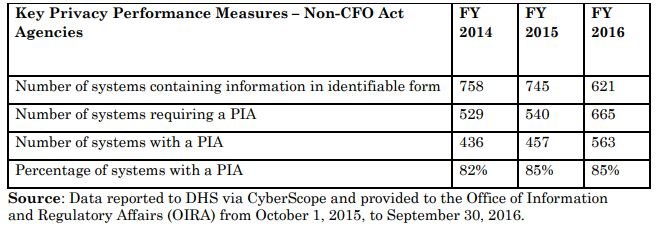
E-government may be an antiquated term, but here’s why it still matters
The Office of Management and Budget released its fiscal 2016 e-government implementation report to Congress in late August.
This is the 14th year of the Office of Management and Budget sending to Congress the annual e-government report. Despite the fact the Obama administration tried to convince lawmakers the report, required by the E-Government Act of 2002, was no longer necessary, House and Senate overseers still want the shelfware.
The report remains chock-full of fun facts about e-government — a once-popular term that has been transformed into digital services and digital transformation by the federal community.
OMB released the 2016 e-gov report to Congress in late August.
OMB used to issue two reports on e-government — this one on implementation and another on the benefits of e-government. Unfortunately for us, OMB hasn’t issued an e-government benefits report since 2014, which offered more details on where money is spent.
That benefits report typically was much more valuable because of the details OMB provided about how it spends the e-government fund, or now the Federal Citizen Services Fund.
In fiscal 2016, Congress allocated $65 million for the fund, which is used to run the General Services Administration’s Technology Transformation Service (TTS). In fiscal 2017, OMB estimates GSA will have $61 million for 2018.
House lawmakers approved $55 million for the citizen services fund in fiscal 2017.
OMB also runs the IT Oversight and Reform (ITOR) fund to modernize federal systems. Congress in 2016 approved $30 million to be used for assorted modernization efforts.
For fiscal 2018, OMB zeroed out the e-gov fund, putting all the money in the citizen services fund.
So even without the funding details, there still is plenty of interesting information, even though it’s from 2016.
Here are 12 facts and figures that you should know about the continued impact of e-government:
DisasterAssistance.gov: It hosted 4,095,723 site visits, and registered 360,745 citizens for disaster assistance via call center support and internet transactions (120,233 using desktops, 48,935 using mobile devices, 191,577 using FEMA Call Centers). The report stated the program continues to receive high customer satisfaction scores from survivors using the site, including earning “green” ratings from the Homeland Security Department’s Office of Accessible Systems and Technology and the DHS Office of the Chief Information Officer’s Program Health Assessment.
Geospatial platform: The Interior Department and the Federal Geographic Data Committee established the Geospatial Interoperability Reference Architecture (GIRA) as an online collaboration community within the GeoPlatform, in coordination with the Program Manager for Information Sharing Environment (PM-ISE) to further enable the timely discovery, access, use, and collaboration for the enhancement and sustainment of the GIRA. Additionally, the committee enhanced the map viewer for 2,131 disparate integrated map services, and developed a new platform resource manager (Registry+) for managing and providing rapid access to geospatial data, service, layer and map assets.
Recreation.gov: In 2016, 16 million visitors conducted 31 million sessions and viewed 287 million pages, which represents a 40 percent increase in visitation over 2014.
My Social Security portal: As of September 2016, over 27 million customers registered for “my Social Security,” and conducted nearly 122 million online transactions. Customer satisfaction also remains high with a rating of 89 through the ForeSee E-Government Customer Satisfaction Index.
Benefits.gov: The benefits website provides information for more than 1,200 federal and state benefit programs across 17 federal agencies. It saw nearly 9.4 million site visits in 2016, and reached an all-time high of nearly 1 million monthly site visits in August. Benefits.gov also pioneered “personalization” technology on its site, launching three new premiere site features that allow users to quickly find more benefits relevant to their situation.
PIAs: In 2016, 24 CFO Act agencies and 51 non-CFO Act agencies fell short in their goals to issue privacy impact assessments for every major IT system. OMB reported 77 percent of applicable IT systems in CFO Act agencies and 85 percent of applicable IT systems in non-CFO Act agencies had up-to-date PIAs. The 77 percent figure reported by CFO Act agencies represents a decrease in the compliance rate compared to previous years. In contrast, the 85 percent figure reported by non-CFO Act agencies is the same as the compliance rate from 2015.


USAgov platform: In 2016, the USAGov platform connected people with government information more than 700 million times using websites, social media, publications, email and phone calls through the USA.gov Contact Center.
HistoryHub: Last year marked the start of a new approach to customer service for the National Archives and Records Administration (NARA) with the launch of History Hub. History Hub offers tools such as discussions boards, blogs and community pages to bring people together around historical topics of interest. In the months since the launch, more than 1,700 registered users have posted and responded to 400 questions. Over the next two years, NARA will expand the pilot to incorporate the platform into its workflow, market it to a wider audience, and collaborate with similar organizations, such as the Library of Congress, the Smithsonian and state and local archives.
Treasury risk rating process: The Treasury Department developed a new investment risk rating process and algorithm to apply more rigors in its review of the IT investment portfolio toward agency objectives, strategic goals and statutory mandates to complement existing operations and performance metrics. Treasury selected metrics for each investment to show how they facilitate customer service, agency productivity and the adoption of innovative approaches, best practices and how they support various stakeholder groups. To strengthen the link to Treasury’s priorities, major IT investments are annually mapped to specific elements of the agency strategic plan.
E-signatures: At the end of 2016, GSA funded the second year of effort to establish an electronic signatures standard and solution across respective applications. This software will offer differentiated levels of credentialing and authentication in order to achieve interoperability with the identified applications across the government and the public. GSA has a phased approach to introduce digital signatures to user groups across the enterprise. Furthermore, GSA is working on publishing application programming interfaces (APIs) that will enable GSA applications to incorporate digital signing as part of their business process, and are developing a seamless integration with their Enterprise Document Management System (EDMS). The electronic signatures application will also have a significant impact on other agency operations, such as the Office of the Federal Register (OFR) at the Federal Register, which is a part of NARA. In 2016, OFR increased the number of agencies submitting documents electronically by 14 percent as a result of ongoing efforts to promote use of the public key infrastructure (PKI) capability and the Federal Register’s redesigned web portal, which facilitates the authentication and verification of both documents and user credentials and provides new tools for both users and administrators to identify and correct problem submissions.
Regulations.gov: The central e-rulemaking tool for agencies, which was launched in 2003, provides agencies with a platform to post final rules, proposed rules, requests for information and other public documents in order to give the public an opportunity to review and comment on regulatory actions. Use of the commenting feature on FederalRegister.gov more than quadrupled in the last year from 2015 to a total of more than 74,000 comments submitted to agencies through this feature. FederalRegister.gov also is integrated with existing MyFR and social media capabilities on the website. Regulations.gov received more than 4.8 million visits and more than 880,000 comments received via Regulations.gov. The e-rulemaking program offers an application programming interface (API), which connects outside applications to FDMS so interested individuals can both read regulatory information and write comments to be processed through FDMS. In 2016, citizens used the API to submit more than 85,000 comments.
IT training: The Office of Personnel Management offers a wide range of IT courses via the OPM Learning Connection, which makes available more than 300 IT-related courses. The total number of completed courses in the IT-related area for 2016 was 1,079 — a 234 percent increase over 2015. Among these training instances were 279 involving the Microsoft Office Suite, while security, malicious code prevention and privacy learning instances totaled 176.
Return to the Reporter’s Notebook
Copyright © 2025 Federal News Network. All rights reserved. This website is not intended for users located within the European Economic Area.
Jason Miller is executive editor of Federal News Network and directs news coverage on the people, policy and programs of the federal government.
Follow @jmillerWFED
Related Stories

Congress showing little love for digital services in 2017 budget




